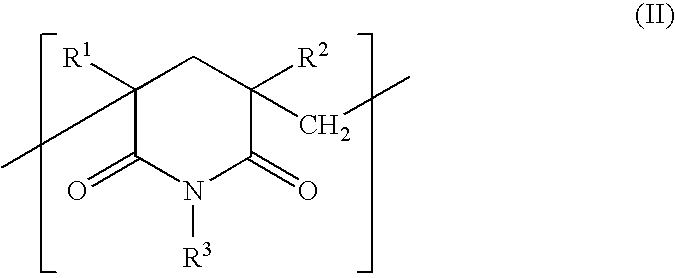Polymethacrylimide plastic foam materials with reduced inflammability in addition to a method for the production thereof
a technology of polymethacrylimide and plastic foam, which is applied in the direction of waterborne vessels, vessel construction, transportation and packaging, etc., can solve the problems of poisonous gases, hcl and hbr, and polymethacrylimides whose flammability is reduced in this way only can be very poorly recycled
- Summary
- Abstract
- Description
- Claims
- Application Information
AI Technical Summary
Benefits of technology
Problems solved by technology
Method used
Image
Examples
example 1
[0066] 1000 g (10.0 parts by weight) of isopropanol were added as a blowing agent to a mixture of 5000 g of methacrylic acid (50.0 parts by weight) and 5000 g of methacrylonitrile (50.0 parts by weight). Also added to the mixture were 20 g (0.20 part by weight) of tert-butyl perpivalate, 3.6 g (0.036 part by weight) of tert-butyl per-2-ethyl-hexanoate, 10 g (0.10 part by weight) of tert-butyl perbenzoate, 400 g (4.0 parts by weight) of Degalan BM 310 (high molecular weight polymethyl methacrylate), 0.5 g (0.005 part by weight) of benzoquinone and 32.0 g (0.32 part by weight) of PAT 1037 as release agent. (Sales: E. and P. Würtz GmbH & Co. KG, Industriegebiet, In der Weide 13+18, 55411 Bingen, Sponsheim.)
[0067] The flame retardants added to the mixture were 10,000 g (100.0 parts by weight) of APP2 (ammonium polyphosphate) from Nordmann, Rassmann GmbH & Co. and 125 g (1.25 parts by weight) of Flameblock 10.0R (zinc sulphide) from Sachtleben. The mixture was stirred until homogeneous ...
example 2
[0070] 1000 g (10.0 parts by weight) of isopropanol were added as a blowing agent to a mixture of 5000 g of methacrylic acid (50.0 parts by weight) and 5000 g of methacrylonitrile (50.0 parts by weight). Also added to the mixture were 20 g (0.20 part by weight) of tert-butyl perpivalate, 3.6 g (0.036 part by weight) of tert-butyl per-2-ethyl-hexanoate, 10 g (0.10 part by weight) of tert-butyl perbenzoate, 400 g (4.0 parts by weight) of Degalan BM 310 (high molecular weight polymethyl methacrylate), 0.5 g (0.005 part by weight) of benzoquinone and 32.0 g (0.32 part by weight) of PAT 1037 as release agent.
[0071] The flame retardants added to the mixture were 10,000 g (100.0 parts by weight) of APP2 (ammonium polyphosphate) from Nordmann, Rassmann GmbH & Co. and 250 g (2.5 parts by weight) of Flameblock 10.0R (zinc sulphide) from Sachtleben. The mixture was stirred until homogeneous and then polymerized at 42° C. for 20 h in a cell formed from two glass plates of size 50×50 cm and an ...
example 3
[0074] 1000 g (10.0 parts by weight) of isopropanol were added as a blowing agent to a mixture of 5000 g of methacrylic acid (50.0 parts by weight) and 5000 g of methacrylonitrile (50.0 parts by weight). Also added to the mixture were 20 g (0.20 part by weight) of tert-butyl perpivalate, 3.6 g (0.036 part by weight) of tert-butyl per-2-ethyl-hexanoate, 10 g (0.10 part by weight) of tert-butyl perbenzoate, 500 g (5.0 parts by weight) of Degalan BM 310 (high molecular weight polymethyl methacrylate), 0.5 g (0.005 part by weight) of benzoquinone and 32.0 g (0.32 part by weight) of PAT 1037 as release agent.
[0075] The flame retardants added to the mixture were 10,000 g (100.0 parts by weight) of APP2 (ammonium polyphosphate) from Nordmann, Rassmann GmbH & Co. and 375 g (3.75 parts by weight) of Flameblock 10.0R (zinc sulphide) from Sachtleben. The mixture was stirred until homogeneous and then polymerized at 45° C. for 19.5 h in a cell formed from two glass plates of size 50×50 cm and ...
PUM
| Property | Measurement | Unit |
|---|---|---|
| Percent by mass | aaaaa | aaaaa |
| Percent by mass | aaaaa | aaaaa |
| Percent by mass | aaaaa | aaaaa |
Abstract
Description
Claims
Application Information
 Login to View More
Login to View More - R&D
- Intellectual Property
- Life Sciences
- Materials
- Tech Scout
- Unparalleled Data Quality
- Higher Quality Content
- 60% Fewer Hallucinations
Browse by: Latest US Patents, China's latest patents, Technical Efficacy Thesaurus, Application Domain, Technology Topic, Popular Technical Reports.
© 2025 PatSnap. All rights reserved.Legal|Privacy policy|Modern Slavery Act Transparency Statement|Sitemap|About US| Contact US: help@patsnap.com

